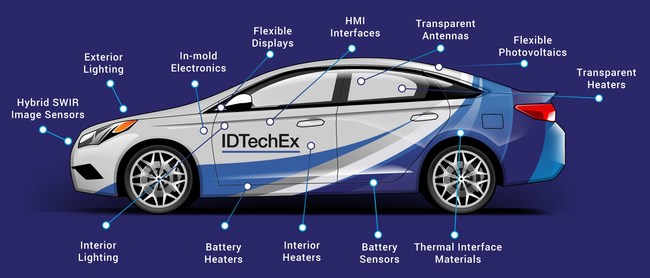IDTechEx has released a new technical market research report, “Printed and Flexible Electronics for Automotive Applications 2021-2031: Technologies and Markets“, on the current status of printed/flexible electronics in all aspects of automotive design and manufacturing, along with future opportunities created by these transitions.
It is an exciting time for the automotive industry, with technological transitions towards electric vehicles and increased autonomy occurring simultaneously. This of course creates extensive opportunities for many new technologies, including printed/flexible electronics. For example, the ability to make electronics on thin flexible substrates enables weight to be reduced, a key consideration for electric vehicles. Furthermore, the conformality associated with flexible electronics is highly suited to emerging automotive interior design trends with organic curves replacing flat surfaces.
This new IDTechEx report, “Printed and Flexible Electronics for Automotive Applications 2021-2031: Technologies and Markets”, is structured around three key technological transitions: electrification, autonomy, and an increased focus on the interior for differentiation.
Electric vehicles. The accelerating transition to electric vehicles is well documented, with multiple countries announcing that sales of petrol/diesel fuelled new cars will become illegal at various points in the 2030s. It is clearly desirable for EV batteries to always work as efficiently as possible to increase vehicle range for a given weight. However, battery capacity is strongly dependent on temperature. This creates an opportunity for printed arrays of temperature sensors to provide local monitoring and for printed heaters to be integrated within the same functional film.
Increased levels of autonomy. Vehicles across the price range now contain sophisticated ‘advanced driver assistance systems (ADAS)’. Over time the level of autonomy will increase, with full Level 5 autonomy expected in some vehicles within a decade. This creates opportunities for multiple sensor technologies and associated features such as transparent heaters, integrated antennas, and even low-resolution flexible displays for the exterior to interact with pedestrians.
Differentiation shifts from powertrain to interior/cockpit. Car manufacturers are increasingly turning to interior design and features to differentiate their products. Given their lightweight and conformable nature, this transition means that interior applications arguably provide the greatest automotive opportunity for printed/flexible electronics. This trend is already being seen with the rapidly increasing adoption of displays, which is set to continue and extend to curved and flexible displays.
Human machine interface (HMI) technologies, more simply described as pressure or touch sensors, are especially promising. Already widely used in seat occupancy sensors, printed pressure sensors are likely to find their way into control panels to provide a wider range of inputs than purely capacitive touch sensors without the expense of mechanical switches.
Many of these touch sensors are likely to be produced via in-mold electronics. By combining the electronics with the thermoformed plastic, it enables integrated systems such as center consoles and overhead control panels to be much lighter, simpler, and easier to manufacture. Indeed, IDTechEx forecast IME to be an approximately $1.3 bn market by 2031.
Other opportunities for printed/flexible electronics within vehicle interiors include printed heaters, which enable heaters to be incorporated within touchpoints. This is significantly more efficient than space heating through the ventilation system, and much more responsive – flexible printed heaters can even be transparent!
Image Licensed by: Pixabay.com
Related News:
New SAS Viya offerings help better manage and navigate big data for AI and analytics


